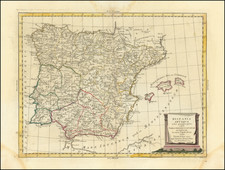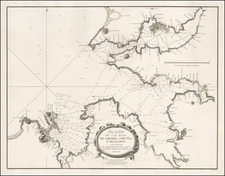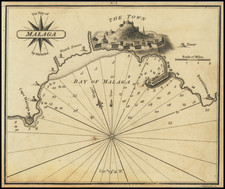A Contemporary Plan of the Siege of Valencia
Detailed map of the Siege of Valencia in 1812, with an extensive manuscript key at the left side of the map providing military details of the Seige, which was led by Louis-Gabriel Suchet, one of Napoleon's primary military leaders.
The present map is a remarkable mix of manuscript and printed content, illustrating the progress of the battle. So, for example, while most of the fortifications and troop positions are printed, There are two sets of Division and Brigade positions at the bottom of the map, two sets of positions at the very top of the map and two sets of positions at the left which are entirely in manuscript, as is the elaborate key at the left of the map and the scaleof miles at the bottom.
Because of Suchet's success in this battle, he was awarded the title of Duke of Albufera (a neighboring area), on January 24, 1812.
Siege of Valencia
The Siege of Valencia from November 3, 1811 to January 9, 1812. The battle saw Marshal Louis Gabriel Suchet's French Army of Aragon besiege Captain General Joaquín Blake y Joyes' forces in the city of Valencia, Spain during the Peninsular War. The French forces ultimately prevailed, resulting in a Spanish surrender at the conclusion of the siege, although another 7,000 Spaniards escaped from the trap. Suchet quickly converted Valencia into an important base of operations.
Following the Duke of Wellington's defeat of Marshal Auguste Marmont at the Battle of Salamanca on July 22, 1812, King Joseph Bonaparte abandoned Madrid on August 11. Because Suchet had a secure base at Valencia, Joseph and Marshal Jean-Baptiste Jourdan retreated there and were joined by Marshals Suchet and Nicolas Soult. Together, Joseph and the three marshals worked out a plan to recapture Madrid and drive Wellington from central Spain. Their subsequent counteroffensive caused the British general to lift the Siege of Burgos and retreat to Portugal in the autumn of 1812.










![[Penisola Castle / Valencian/Catalan Coast] Coste d'Espagne depuis Peniscola Jusqu'au Hamau du Canard ou Alcanario (hand drawn map)](https://storage.googleapis.com/raremaps/img/small/91695.jpg)
![[Grenada] Plano de Granada Comprobado con el Instituto Geogco. y Revisado por arquiteto municipal (Spain)](https://storage.googleapis.com/raremaps/img/small/61742.jpg)

![[ Andalusia ] Hispalensis Conventus Delineatio](https://storage.googleapis.com/raremaps/img/small/96183.jpg)
